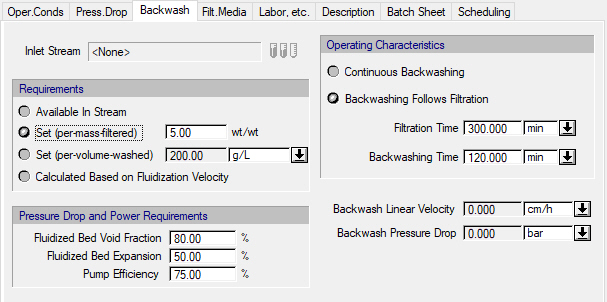

The following table shows a brief description of the variables appearing in this tab. The table also displays their default values and their generally acceptable range:
|
Variable |
Default Value |
Range |
|
|
||
|
○ Inlet Stream |
<None> |
Any Input Port |
|
◙ Inlet Stream Amount Per Mass Filtered (wt/wt) |
5.0 |
Positive |
|
◙ Inlet Stream Amount Per Volume Washed (kg/m3) |
200.0 |
Positive |
|
○ Fluidized Bed Void Fraction (%) |
80.0 |
0 – 100 |
|
○ Fluidized Bed Expansion (%) |
50.0 |
0 – 100 |
|
○ Pump Efficiency (%) |
75.0 |
0 – 100 |
|
◙ Filtration Time (h) |
5.0 |
Positive |
|
◙ Backwashing Time (h) |
2.0 |
Positive |
|
● Backwash Linear Velocity (m/min) |
0.0 |
Positive |
|
● Backwash Pressure Drop (kPa) |
0.0 |
Positive |
Symbol Key: ○ User-specified value (always input); ● Calculated value (always output); ◙ Sometimes input, sometimes output
The following list describes the available specification choices in this tab; for more details on how these are implemented, see Granular Media Filtration: Modeling Calculations.
•Backwash Requirement Options...
The backwash requirement can be the one available in the inlet stream or specified per mass of solids removed, per volume of liquid filtered, or calculated based on fluidization velocity. Further, backwashing can take place continuously or alternating with filtration.